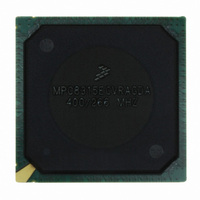MPC8315ECVRAGDA Freescale Semiconductor, MPC8315ECVRAGDA Datasheet - Page 7

MPC8315ECVRAGDA
Manufacturer Part Number
MPC8315ECVRAGDA
Description
MPU POWERQUICC II PRO 620-PBGA
Manufacturer
Freescale Semiconductor
Datasheet
1.MPC8315VRADDA.pdf
(112 pages)
Specifications of MPC8315ECVRAGDA
Processor Type
MPC83xx PowerQUICC II Pro 32-Bit
Speed
400MHz
Voltage
1V
Mounting Type
Surface Mount
Package / Case
620-PBGA
Processor Series
MPC8xxx
Core
e300
Data Bus Width
32 bit
Maximum Clock Frequency
50 MHz
Maximum Operating Temperature
+ 105 C
Mounting Style
SMD/SMT
Minimum Operating Temperature
- 40 C
Leaded Process Compatible
Yes
Rohs Compliant
Yes
Peak Reflow Compatible (260 C)
Yes
Lead Free Status / RoHS Status
Lead free / RoHS Compliant
Features
-
Lead Free Status / Rohs Status
Lead free / RoHS Compliant
Available stocks
Company
Part Number
Manufacturer
Quantity
Price
Company:
Part Number:
MPC8315ECVRAGDA
Manufacturer:
Freescale Semiconductor
Quantity:
135
Company:
Part Number:
MPC8315ECVRAGDA
Manufacturer:
FREESCAL
Quantity:
36
Company:
Part Number:
MPC8315ECVRAGDA
Manufacturer:
Freescale Semiconductor
Quantity:
10 000
Part Number:
MPC8315ECVRAGDA
Manufacturer:
FREESCALE
Quantity:
20 000
2.13
The serial peripheral interface (SPI) allows the MPC8315E to exchange data between other PowerQUICC
family chips, Ethernet PHYs for configuration, and peripheral devices such as EEPROMs, real-time
clocks, A/D converters, and ISDN devices.
The SPI is a full-duplex, synchronous, character-oriented channel that supports a four-wire interface
(receive, transmit, clock, and slave select). The SPI block consists of transmitter and receiver sections, an
independent baud-rate generator, and a control unit.
2.14
The integrated four-channel DMA controller includes the following features:
There is one I
for expansion and system development.
The DUART supports full-duplex operation and is compatible with the PC16450 and PC16550
programming models. 16-byte FIFOs are supported for both the transmitter and the receiver.
The enhanced local bus controller (eLBC) port allows connections with a wide variety of external DSPs
and ASICs. Three separate state machines share the same external pins and can be programmed separately
to access different types of devices. The general-purpose chip select machine (GPCM) controls accesses
to asynchronous devices using a simple handshake protocol. The three user programmable machines
(UPMs) can be programmed to interface to synchronous devices or custom ASIC interfaces. Each chip
select can be configured so that the associated chip interface can be controlled by the GPCM or UPM
controller. Both may exist in the same system. The local bus can operate at up to 66 MHz.
The system timers include the following features: periodic interrupt timer, real time clock, software
watchdog timer, and two general-purpose timer blocks.
Freescale Semiconductor
•
•
•
•
•
•
Wake-up from Ethernet (magic packet), USB, GPIO, and PCI (PME input as host) while in the D1,
D2 and D3hot states
A new low-power standby power management state called D3warm
— The PMC, one Ethernet port, and the GTM block remain powered via a split power supply
— Wake-up events include Ethernet (magic packet), GTM, GPIO, or IRQ inputs and cause the
— PCI agent mode is not be supported in D3warm state
PCI Express-based PME events are not supported
Allows chaining (both extended and direct) through local memory-mapped chain descriptors
(accessible by local masters)
Misaligned transfer capability for source/destination address
Supports external DREQ, DACK and DONE signals
DMA Controller, I
Serial Peripheral Interface (SPI)
(eLBC), and Timers
controlled through an external power switch
device to transition back to normal operation
2
C controller. This synchronous, multi-master buses can be connected to additional devices
MPC8315E PowerQUICC
2
C, DUART, Enhanced Local Bus Controller
™
II Pro Processor Hardware Specifications, Rev. 0
MPC8315E Features
7












